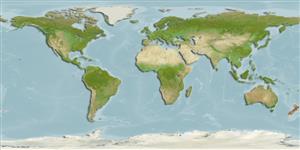>
Gobiesociformes (Clingfishes) >
Gobiesocidae (Clingfishes and singleslits) > Haplocylicinae
Etymology: Gastroscyphus: Greek, gaster = stomach + Greek, kyphos = curved, bent (Ref. 45335); hectoris: Named after Sir James Hector, natural historian and Director of the Colonial Museum (Ref. 9003).
Eponymy: Dr Sir James Hector (1834–1907) was a Scottishborn Canadian geologist who took his medical degree at Edinburgh and, as both geologist and surgeon, was part of the Palliser expedition to western North America (1857–1860). [...] (Ref. 128868), visit book page.
More on author: Günther.
Environment: milieu / climate zone / depth range / distribution range
Ecologie
marien demersaal; diepte 0 - 10 m (Ref. 9003). Temperate
Southwest Pacific: endemic to New Zealand.
Grootte / Gewicht / Leeftijd
Maturity: Lm ? range ? - ? cm
Max length : 6.4 cm SL mannelijk / geslacht onbekend; (Ref. 9003); max. gerapporteerde leeftijd: 4 Jaren (Ref. 9003)
Korte beschrijving
Determinatiesleutels | Morfologie | Morfometrie
Dorsale stekels (totaal) : 0; Dorsale zachte stralen (totaal) : 6 - 8; Anale stekels: 0; Anale zachte stralen: 6 - 7. Color uniform or blotched reddish to olive green or brown dorsally, paler ventrally. A bar of lighter color along the head between the eyes and a narrow horizontal dark stripe from the snout to the gill cover separating the darker dorsal pigment from the paler lower surface. Occasionally a variable row of white spots along the side of the body. Distinguished from other clingfish by its distinctive body form (robust and tapers abruptly behind the dorsal and anal fins).
Commonly amongst brown algae (Cystophora) in rock pools at the low tide level and subtidal areas. Sometimes found on seaweed exposed at low tide. Swims towards cover and positions itself like drifting algae (heads up tail down position, sculling with the pectoral fins) when disturbed.
Levenscyclus en paargedrag
Maturiteit | Voortplanting | Paaien | Eieren | Fecunditeit | Larven
Paulin, C. and C. Roberts, 1992. The rockpool fishes of New Zealand (Te ika aaria o Aotearoa). Museum of New Zealand (Te Papa Tongarewa). 177 p. (Ref. 9003)
Status op de Rode Lijst van het IUCN (Ref. 130435: Version 2024-1)
Gevaar voor de mens
Harmless
Gebruik door de mens
Tools
Speciale rapporten
Download XML
Internetbronnen
Estimates based on models
Preferred temperature (Ref.
123201): 13.8 - 18.3, mean 16.4 °C (based on 99 cells).
Fylogenetische diversiteitsindex (Ref.
82804): PD
50 = 1.0000 [Uniqueness, from 0.5 = low to 2.0 = high].
Bayesian length-weight: a=0.00398 (0.00163 - 0.00973), b=3.13 (2.91 - 3.35), in cm total length, based on LWR estimates for this (Sub)family-body shape (Ref.
93245).
Trofisch niveau (Ref.
69278): 3.3 ±0.3 se; based on size and trophs of closest relatives
Weerstandsvermogen (Ref.
120179): Gemiddeld, minimale populatieverdubbelingstijd 1,4-4,4 jaar (tmax=4).
Fishing Vulnerability (Ref.
59153): Low vulnerability (10 of 100).
